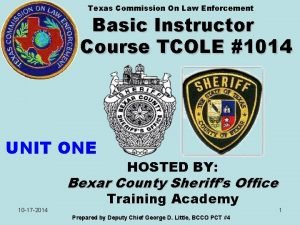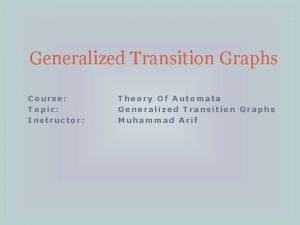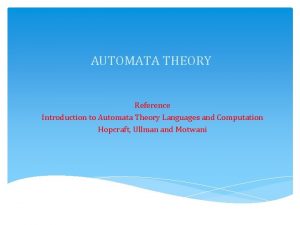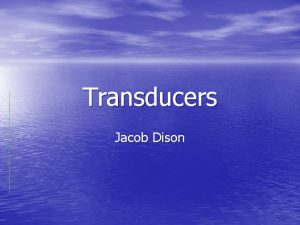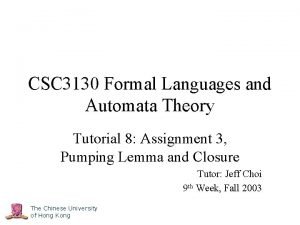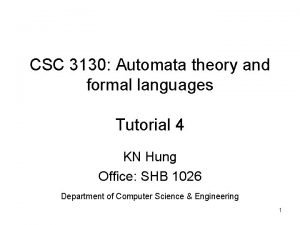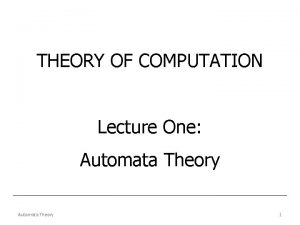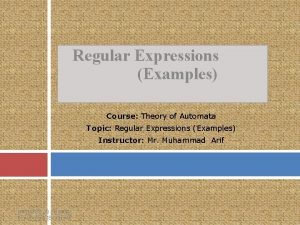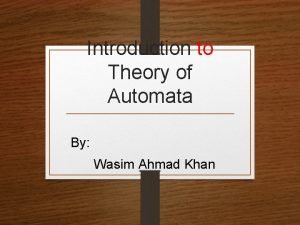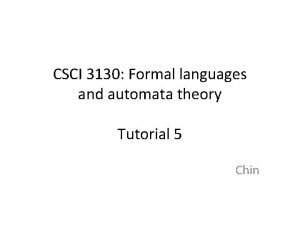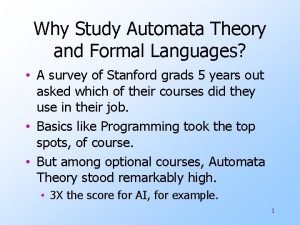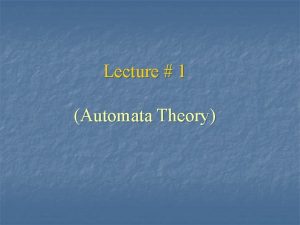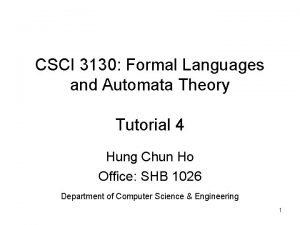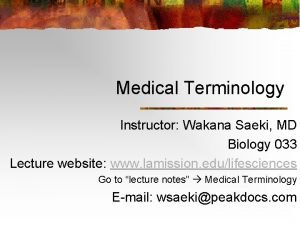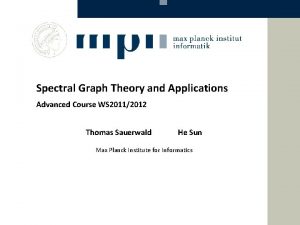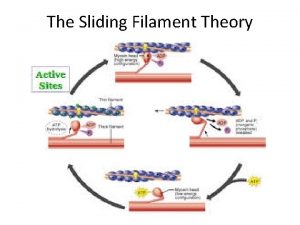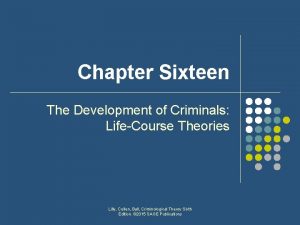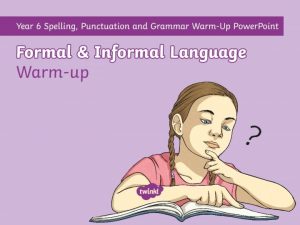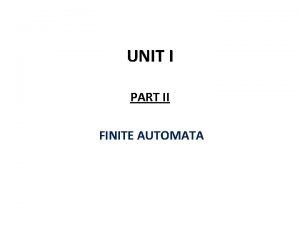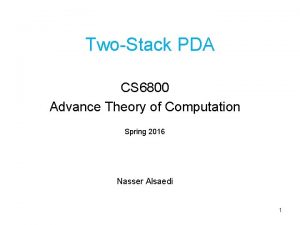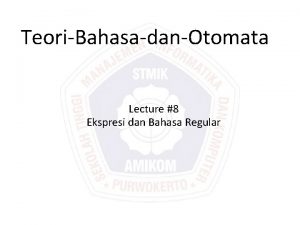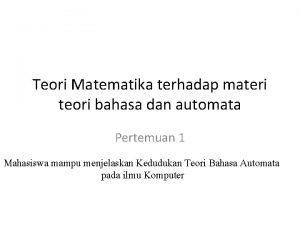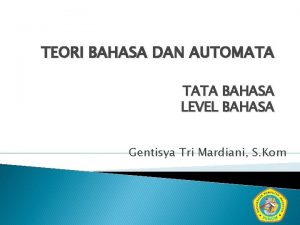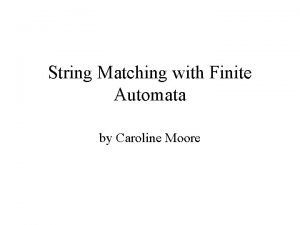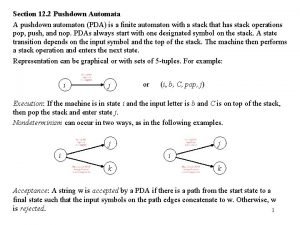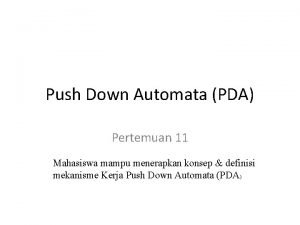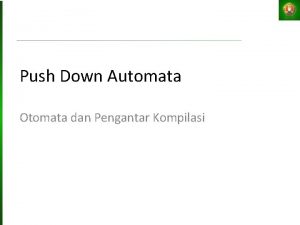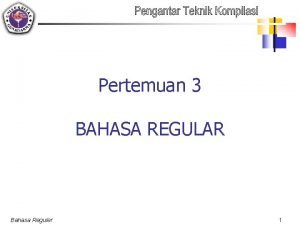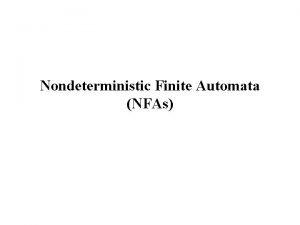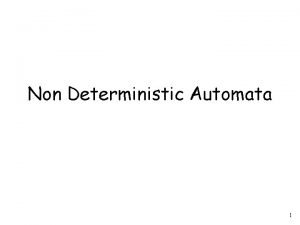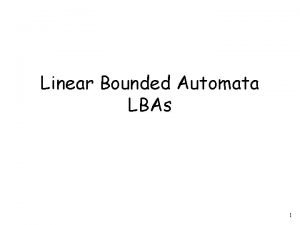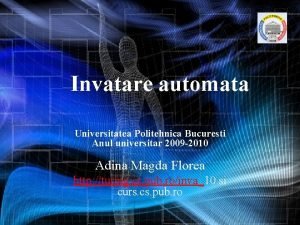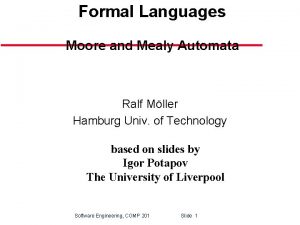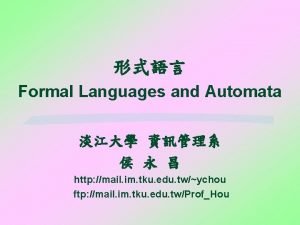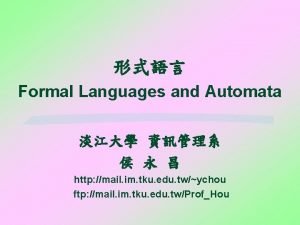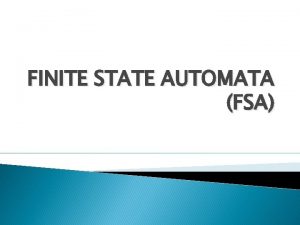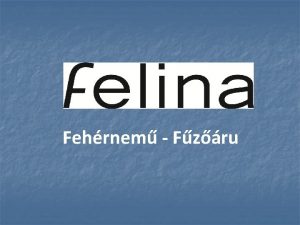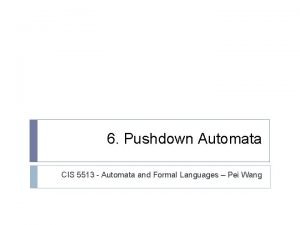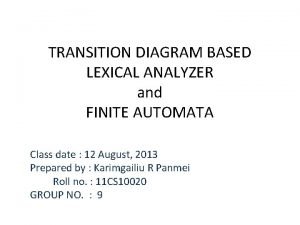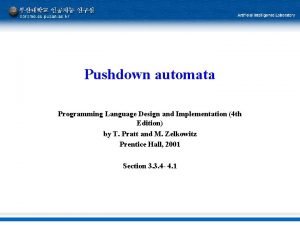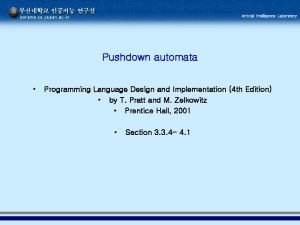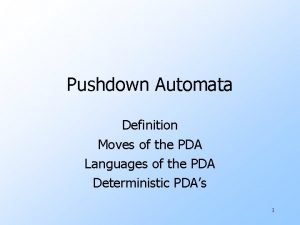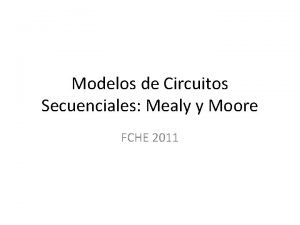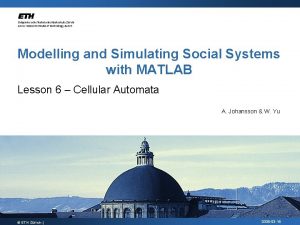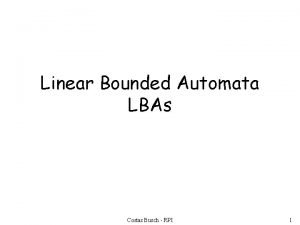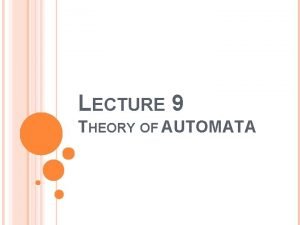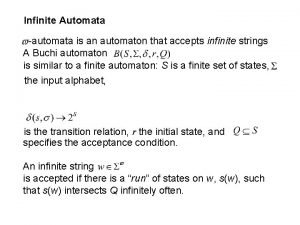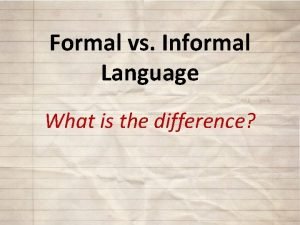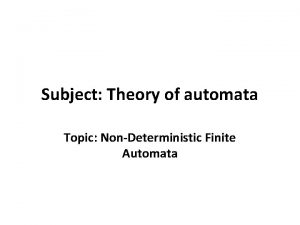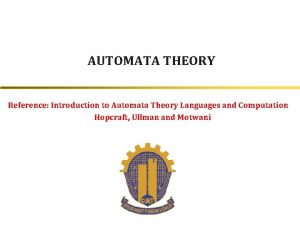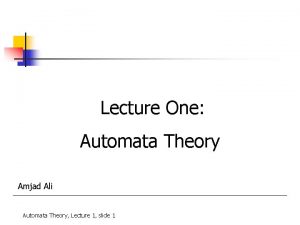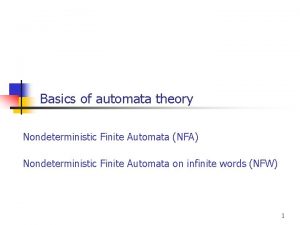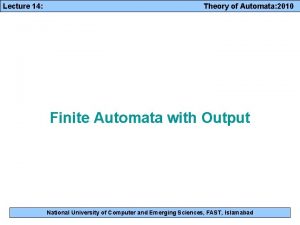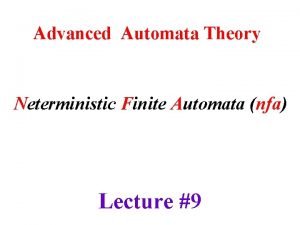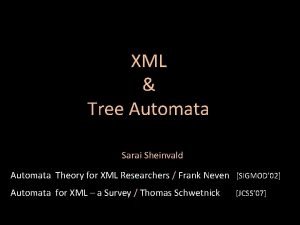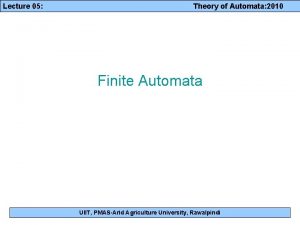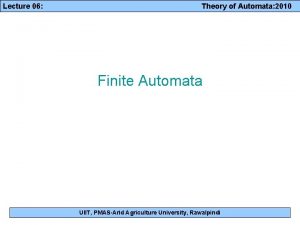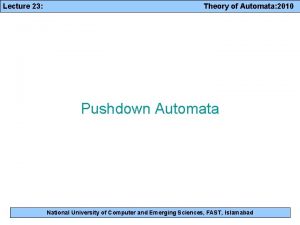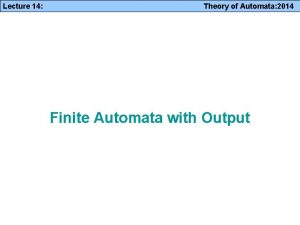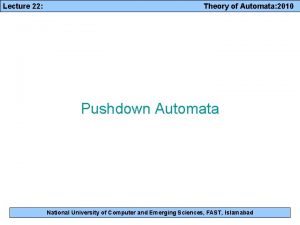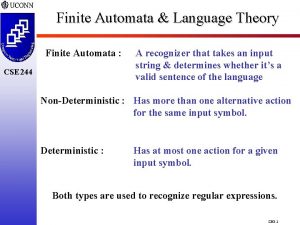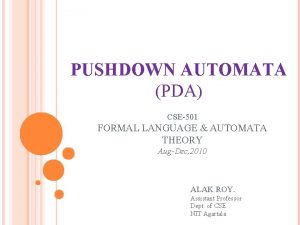Theory of Automata Course Topic Instructor Theory of











![Chapter 1: Introduction to Theory of Automata and Regular Expressions [Week#01, 02] - Intro Chapter 1: Introduction to Theory of Automata and Regular Expressions [Week#01, 02] - Intro](https://slidetodoc.com/presentation_image/46dd54bfbd8313a302478fab3b7acbc8/image-12.jpg)
![What Does Automata Mean? [Week#01, 02] - Intro to TOA & Regular Expressions 13 What Does Automata Mean? [Week#01, 02] - Intro to TOA & Regular Expressions 13](https://slidetodoc.com/presentation_image/46dd54bfbd8313a302478fab3b7acbc8/image-13.jpg)
![What Does Automata Mean? [Week#01, 02] - Intro to TOA & Regular Expressions 14 What Does Automata Mean? [Week#01, 02] - Intro to TOA & Regular Expressions 14](https://slidetodoc.com/presentation_image/46dd54bfbd8313a302478fab3b7acbc8/image-14.jpg)
![What Does Automata Mean? [Week#01, 02] - Intro to TOA & Regular Expressions 15 What Does Automata Mean? [Week#01, 02] - Intro to TOA & Regular Expressions 15](https://slidetodoc.com/presentation_image/46dd54bfbd8313a302478fab3b7acbc8/image-15.jpg)
![What Does Automata Mean? [Week#01, 02] - Intro to TOA & Regular Expressions 16 What Does Automata Mean? [Week#01, 02] - Intro to TOA & Regular Expressions 16](https://slidetodoc.com/presentation_image/46dd54bfbd8313a302478fab3b7acbc8/image-16.jpg)
![[Week#01, 02] - Intro to TOA & Regular Expressions 17 [Week#01, 02] - Intro to TOA & Regular Expressions 17](https://slidetodoc.com/presentation_image/46dd54bfbd8313a302478fab3b7acbc8/image-17.jpg)
![[Week#01, 02] - Intro to TOA & Regular Expressions 18 [Week#01, 02] - Intro to TOA & Regular Expressions 18](https://slidetodoc.com/presentation_image/46dd54bfbd8313a302478fab3b7acbc8/image-18.jpg)
![What Does Automata Mean? [Week#01, 02] - Intro to TOA & Regular Expressions 19 What Does Automata Mean? [Week#01, 02] - Intro to TOA & Regular Expressions 19](https://slidetodoc.com/presentation_image/46dd54bfbd8313a302478fab3b7acbc8/image-19.jpg)
![What Does Automata Mean? [Week#01, 02] - Intro to TOA & Regular Expressions 20 What Does Automata Mean? [Week#01, 02] - Intro to TOA & Regular Expressions 20](https://slidetodoc.com/presentation_image/46dd54bfbd8313a302478fab3b7acbc8/image-20.jpg)


![Finite Automaton [Week#01, 02] - Intro to TOA & Regular Expressions 23 Finite Automaton [Week#01, 02] - Intro to TOA & Regular Expressions 23](https://slidetodoc.com/presentation_image/46dd54bfbd8313a302478fab3b7acbc8/image-23.jpg)
![Pushdown Automaton [Week#01, 02] - Intro to TOA & Regular Expressions 24 Pushdown Automaton [Week#01, 02] - Intro to TOA & Regular Expressions 24](https://slidetodoc.com/presentation_image/46dd54bfbd8313a302478fab3b7acbc8/image-24.jpg)
![Turing Machine [Week#01, 02] - Intro to TOA & Regular Expressions 25 Turing Machine [Week#01, 02] - Intro to TOA & Regular Expressions 25](https://slidetodoc.com/presentation_image/46dd54bfbd8313a302478fab3b7acbc8/image-25.jpg)
![Power of Automata [Week#01, 02] - Intro to TOA & Regular Expressions 26 Power of Automata [Week#01, 02] - Intro to TOA & Regular Expressions 26](https://slidetodoc.com/presentation_image/46dd54bfbd8313a302478fab3b7acbc8/image-26.jpg)





































































- Slides: 95

Theory of Automata Course: Topic: Instructor: Theory of Automata Intro and Regular Languages Mr. Muhammad Arif

Course Assessment Criteria Final Exam p Midterm p Quizzes p 4 best quizzes out of 6 Assignments p Presentation + Report p Total p [Week#01, 02] - Intro to TOA & Regular Expressions 50% 25% 10% 05% 100% 2

Literature p p Lecture Slides n Soft copies (. pdf) n Hard copies Research Papers n Research papers from magazines/internet [Week#01, 02] - Intro to TOA & Regular Expressions 3

Course contents in brief p p p Finite State Models: Language definitions preliminaries Regular expressions/Regular languages, Finite automata (FAs), Transition graphs (TGs), NFAs, kleene’s theorem, Transducers (automata with output), Pumping lemma and non regular language Grammars and PDA Context free grammars, Derivations, derivation trees and ambiguity, Simplifying CFLs, Normal form grammars and parsing, Push-down Automata, Pumping lemma and non-context free languages, Decidability, Chomsky’s hierarchy of grammars Turing Machines Theory: Turing machines, Post machine, Variations on TM, TM encoding, Universal Turing Machine Context sensitive Grammars, Defining Computers by TMs. [Week#01, 02] - Intro to TOA & Regular Expressions 4

Purpose of Course p p In this Course our concern is not with actual hardware and software. More interested in capability of computers. specifically, what can and what cannot be done by any existing computer or any computer ever built in the future. We will study different types of theoretical machines that are mathematical models for actual physical processes. [Week#01, 02] - Intro to TOA & Regular Expressions 5

Cont…. p p p By considering the possible inputs on which these machines can work, we can analyze their various strengths and weaknesses. We can then develop what we may believe to be the most powerful machine possible. Surprisingly, it will not be able to perform every task. [Week#01, 02] - Intro to TOA & Regular Expressions 6

Cont…. p In particular, the way we shall be studying about computers is to build mathematical models, called machines, and then to study their limitations by analyzing the types of inputs on which they can operate successfully. p The collection of these successful inputs is called the language of the machine [Week#01, 02] - Intro to TOA & Regular Expressions 7

Cont…. p p Every time we introduce a new machine, we will learn its language; and every time we develop a new language, we will try to find a machine that corresponds to it. We will study different types of theoretical machines that are mathematical models for actual physical processes. By considering the possible inputs on which these machines can work, we can analyze their various strengths and weaknesses. [Week#01, 02] - Intro to TOA & Regular Expressions 8

Recommended Books p p Introduction to Computer Theory, Denial Cohen, John Wiley & Sons, Inc. Theory of Automata By C. J. Martin Introduction to Automata Theory, Languages & Computation, J Hopcraft, D. Ullman Languages & Machines, An Into to the Theory of Computer Science, 2/e Thomas A. Sudkamp, Addison Wesley. [Week#01, 02] - Intro to TOA & Regular Expressions 9

Important Issues Attendance policy and late comers p Assignments policy p n n All typed assignments Title page: Registration number p Course title p Assignment name p Assignment number p Submission date p n Font size of the headings should be 12, Bold and may be underlined [Week#01, 02] - Intro to TOA & Regular Expressions 10

Important Issues n n n n n Text font size should be 12 Font style should be Times, Arial or Book Antiqua Page numbers Default page settings Table of contents for large assignments (applicable for more than 5 pages) Single spacing Justified No color except black and blue References of the source material used (no copied material will be accepted) [Week#01, 02] - Intro to TOA & Regular Expressions 11
![Chapter 1 Introduction to Theory of Automata and Regular Expressions Week01 02 Intro Chapter 1: Introduction to Theory of Automata and Regular Expressions [Week#01, 02] - Intro](https://slidetodoc.com/presentation_image/46dd54bfbd8313a302478fab3b7acbc8/image-12.jpg)
Chapter 1: Introduction to Theory of Automata and Regular Expressions [Week#01, 02] - Intro to TOA & Regular Expressions 12
![What Does Automata Mean Week01 02 Intro to TOA Regular Expressions 13 What Does Automata Mean? [Week#01, 02] - Intro to TOA & Regular Expressions 13](https://slidetodoc.com/presentation_image/46dd54bfbd8313a302478fab3b7acbc8/image-13.jpg)
What Does Automata Mean? [Week#01, 02] - Intro to TOA & Regular Expressions 13
![What Does Automata Mean Week01 02 Intro to TOA Regular Expressions 14 What Does Automata Mean? [Week#01, 02] - Intro to TOA & Regular Expressions 14](https://slidetodoc.com/presentation_image/46dd54bfbd8313a302478fab3b7acbc8/image-14.jpg)
What Does Automata Mean? [Week#01, 02] - Intro to TOA & Regular Expressions 14
![What Does Automata Mean Week01 02 Intro to TOA Regular Expressions 15 What Does Automata Mean? [Week#01, 02] - Intro to TOA & Regular Expressions 15](https://slidetodoc.com/presentation_image/46dd54bfbd8313a302478fab3b7acbc8/image-15.jpg)
What Does Automata Mean? [Week#01, 02] - Intro to TOA & Regular Expressions 15
![What Does Automata Mean Week01 02 Intro to TOA Regular Expressions 16 What Does Automata Mean? [Week#01, 02] - Intro to TOA & Regular Expressions 16](https://slidetodoc.com/presentation_image/46dd54bfbd8313a302478fab3b7acbc8/image-16.jpg)
What Does Automata Mean? [Week#01, 02] - Intro to TOA & Regular Expressions 16
![Week01 02 Intro to TOA Regular Expressions 17 [Week#01, 02] - Intro to TOA & Regular Expressions 17](https://slidetodoc.com/presentation_image/46dd54bfbd8313a302478fab3b7acbc8/image-17.jpg)
[Week#01, 02] - Intro to TOA & Regular Expressions 17
![Week01 02 Intro to TOA Regular Expressions 18 [Week#01, 02] - Intro to TOA & Regular Expressions 18](https://slidetodoc.com/presentation_image/46dd54bfbd8313a302478fab3b7acbc8/image-18.jpg)
[Week#01, 02] - Intro to TOA & Regular Expressions 18
![What Does Automata Mean Week01 02 Intro to TOA Regular Expressions 19 What Does Automata Mean? [Week#01, 02] - Intro to TOA & Regular Expressions 19](https://slidetodoc.com/presentation_image/46dd54bfbd8313a302478fab3b7acbc8/image-19.jpg)
What Does Automata Mean? [Week#01, 02] - Intro to TOA & Regular Expressions 19
![What Does Automata Mean Week01 02 Intro to TOA Regular Expressions 20 What Does Automata Mean? [Week#01, 02] - Intro to TOA & Regular Expressions 20](https://slidetodoc.com/presentation_image/46dd54bfbd8313a302478fab3b7acbc8/image-20.jpg)
What Does Automata Mean? [Week#01, 02] - Intro to TOA & Regular Expressions 20

What does automata mean? p Automata is Greek letters. Automata is a word formulated from automation, which means machine designing or replacing human beings with machines p It is the plural of automaton, and it means “something that works automatically”. [Week#01, 02] - Intro to TOA & Regular Expressions 21

Different Kinds of Automata p Automata are distinguished by the temporary memory n Finite Automata: no temporary memory n Pushdown Automata: stack n Turing Machines: random access memory [Week#01, 02] - Intro to TOA & Regular Expressions 22
![Finite Automaton Week01 02 Intro to TOA Regular Expressions 23 Finite Automaton [Week#01, 02] - Intro to TOA & Regular Expressions 23](https://slidetodoc.com/presentation_image/46dd54bfbd8313a302478fab3b7acbc8/image-23.jpg)
Finite Automaton [Week#01, 02] - Intro to TOA & Regular Expressions 23
![Pushdown Automaton Week01 02 Intro to TOA Regular Expressions 24 Pushdown Automaton [Week#01, 02] - Intro to TOA & Regular Expressions 24](https://slidetodoc.com/presentation_image/46dd54bfbd8313a302478fab3b7acbc8/image-24.jpg)
Pushdown Automaton [Week#01, 02] - Intro to TOA & Regular Expressions 24
![Turing Machine Week01 02 Intro to TOA Regular Expressions 25 Turing Machine [Week#01, 02] - Intro to TOA & Regular Expressions 25](https://slidetodoc.com/presentation_image/46dd54bfbd8313a302478fab3b7acbc8/image-25.jpg)
Turing Machine [Week#01, 02] - Intro to TOA & Regular Expressions 25
![Power of Automata Week01 02 Intro to TOA Regular Expressions 26 Power of Automata [Week#01, 02] - Intro to TOA & Regular Expressions 26](https://slidetodoc.com/presentation_image/46dd54bfbd8313a302478fab3b7acbc8/image-26.jpg)
Power of Automata [Week#01, 02] - Intro to TOA & Regular Expressions 26

Languages p p p Letters, Words, Sentences Alphabets join to form words Words combine to form sentences Sentences combine to form paragraphs and so on But the matter of fact is not all collections of letters form a valid word and not all collection of words form a valid sentence. [Week#01, 02] - Intro to TOA & Regular Expressions 27

Languages p How can you tell whether a given sentence belongs to a particular languages n n n p p Black is cat the The tea is hot I like chocolates two much Rules give a clue to forming as well as validating sentences. There are two types of languages: n n Formal Languages (Syntactic Languages) Informal Languages (Semantic Languages) [Week#01, 02] - Intro to TOA & Regular Expressions 28

Formal vs. Informal Rules p p Informal language -> abstract languages Incoherent strings are understandable p p Slang, idiom, dialect etc. But Raise ambiguity n Interpretation varies with region p n I am through (Br. E/Am. E) Same words have multiple meanings. p Like, light, base, etc. [Week#01, 02] - Intro to TOA & Regular Expressions 29

Informal languages p p Natural languages are generally defined informally Human brain are capable to understand incoherent even invalid sentences. p p n n You mangoes like We school daily go to Rectify grammatical errors etc. Resolve ambiguity p p Interpret according to context Supporting aids such as Facial expressions and body language etc. [Week#01, 02] - Intro to TOA & Regular Expressions 30

How to Communicate with machines ? p p p Need a language: what sort Machines don’t have human mind though may have its partial imitation Would fail on incorrect or ambiguous input Some recovery or input corrections may be proposed but again very limited. Thus need a precise, explicit and universal definition of communication language [Week#01, 02] - Intro to TOA & Regular Expressions 31

Summary of Languages p Three aspects/specifications n Lexical p n Syntactic p n Defines valid words/units of a language Defines rules for combining the units to form valid sentences (computer programs in context of machines) Semantic Concerned with the interpretation or meaning of a sentence (what output to produce in context of machines) p Affected by ambiguity the most. p [Week#01, 02] - Intro to TOA & Regular Expressions 32

Formal Languages p Word “formal” refers to the fact that all the rules for the language are explicitly stated in terms of what string of symbols can occur n n p No ambiguities Universally uniform understanding Let the machine n n n Interpret an input uniformly every time. i. e. always produces same output for a particular input Avoid crashes because of ambiguity Explicitly reject invalid input [Week#01, 02] - Intro to TOA & Regular Expressions 33

Formal Languages p p Need precise uniformly understandable notation Representations n Alphabet p p Represents a finite set of fundamental units of lanauges, e. g. for English ={a, b, …. z. A, …Z, } Denoted by Σ ∑ = {0, 1} ∑ = {0, 1, 2, 3, 4, 5, 6, 7, 8, 9} p A certain specified set of strings of characters from the alphabet is called the language (set of words) [Week#01, 02] - Intro to TOA & Regular Expressions 34

Formal Languages n List of words Set of all valid words of a given language, e. g. , a language English_Words that contains all valid words of English would have a �= {all entries of the dictionary + punctuation marks and blank space} p Denoted by � p Is � Finite or Infinite set. p n Strings: Concatenation of finite symbols from the alphabets is called a string. p A string a finite sequence of symbols chosen from alphabet. p Example: if Σ ={a, b} then a, abab, aaab, ababa…. p [Week#01, 02] - Intro to TOA & Regular Expressions 35

Formal Languages n Empty String or Null String p p n Empty String is a string which does not contain any letter. It is same as the empty set. It is denoted by capital Greek letter lambda Λ. Words p p In spoken languages not all strings are words. Example: in English if we combine abcd, it does not form any word. Words are strings belonging to some language. Example: if Σ={x} then a language L can be defined as, L={x : n=1, 2, 3…} OR L={x, xxx, xxxx…. . } Here x, xxx…. are the words of L. Note: Not all strings are words but all words are strings n p [Week#01, 02] - Intro to TOA & Regular Expressions 36

Formal Languages n Valid/In-valid Alphabets p n While defining an alphabets, an alphabet may contain letters consisting of group of symbols, e. g. , consider 2 alphabets: Σ 1={B, a. B, bab, d} and Σ 2={B, Ba, bab, d} and a string Babab. B This string may be tokenized in two different ways: (Ba), (bab), (B) p (B), (abab), (B) p n Which shows that the 2 nd group can not be identified as a string, defined over Σ= {a, b} [Week#01, 02] - Intro to TOA & Regular Expressions 37

Formal Languages n Note While defining an alphabet of letters consisting of more than one symbols, no letter should be started with the letter of the same alphabet i. e. one letter should not be the prefix of another. However, a letter may be ended in the letter of same alphabet i. e. one letter may be the suffix of another. p Therefore, Σ 1 is a valid alphabet and Σ 2 is in-valid alphabet. p [Week#01, 02] - Intro to TOA & Regular Expressions 38

Formal Languages n String Variable: p n A letter used for denoting a string. The author uses w, x, y and z as string variable. For example w = 0111100 , x = 123045, z = abbbcdeg String Length: p The number of positions for symbols in the string. For simplicity we can say that it is the number of symbols in the string. For example |w| = 7 , |x| = ? , |z| = ? [Week#01, 02] - Intro to TOA & Regular Expressions 39

Formal Languages n Reverse of a string The reverse of a string s, denoted by rev(s), is obtained by writing the letters of s in reverse order. p Example 1: if s=abc is a string defined over Σ={a, b, c} then Rev(s)= cba p Example 2: if s=Ba. Bbab. Bd is a string defined over Σ={B, a. B, bab, d} then Rev(s)= d. Bbaba. BB p [Week#01, 02] - Intro to TOA & Regular Expressions 40

Defining Languages p The language can be defined in different ways, such as n n Descriptive definition Recursive definition Using Regular expressions (RE) and Using Finite automaton (FA) etc. [Week#01, 02] - Intro to TOA & Regular Expressions 41

Defining Languages p p Define alphabet set Define rules forming valid words and sequences of words from n n Called grammar Can be descriptive p n Limitations of informalism Can be mathematical p Can also define supporting functions e. g. , length(X), reverse(x) [Week#01, 02] - Intro to TOA & Regular Expressions 42

Defining languages p Example ={a, b, …z} n n L = {all words formed only of odd number of xs} L = {xn | n is odd} L = {all words of length less than or equal to 4} PALINDROME ={Λ, all strings x such that reverse (x) = x} [Week#01, 02] - Intro to TOA & Regular Expressions 43

Finite vs. Infinite Languages n Finite Languages Countable set of words p Can be defined by rigorously listing the words in � p E. g. English_Words p n Infinite Languages Infinite set of valid words p Cant be listed completely p E. g. English_Sentences p [Week#01, 02] - Intro to TOA & Regular Expressions 44

Infinite Languages p p Most of the languages are infinite How can u check whether a word belongs to a language if it is n Finite p n Checking its entry in � Infinite p Validating against rules [Week#01, 02] - Intro to TOA & Regular Expressions 45

Defining Language p p Define alphabet set Define rules forming valid words and sequences of words from Σ n n This is called grammar Can be descriptive p n Limitations of informalism Can be mathematical p Can also define supporting functions e. g. , length(X), reverse(x) [Week#01, 02] - Intro to TOA & Regular Expressions 46

bilawalsheikh 333. blogspot. com Theory of Automata (BSCS)-4 A Fall 2012, BU Islamabad Defining Languages p Language defining rules can be of two kinds; 1. 2. They can either tell us how to test a string of alphabet letters that we might be presented with, to see if it is a valid word or They can tell us how to construct all the words in the language by some clear procedures (discussed later) [Week#01, 02] - Intro to TOA & Regular Expressions 47

bilawalsheikh 333. blogspot. com Theory of Automata (BSCS)-4 A Fall 2012, BU Islamabad Defining Languages p Example n Lets discuss a simple example of language, if we start with an alphabet having only one letter, the letter x p n Σ = {x} We can define a language by saying any nonempty string of alphabet characters L = {x xx xxxx …} p L = {x^n for n =1, 2, 3, …} p n Because of the way we have defined it, this language does not include the null string (Λ) [Week#01, 02] - Intro to TOA & Regular Expressions 48

bilawalsheikh 333. blogspot. com Theory of Automata (BSCS)-4 A Fall 2012, BU Islamabad Defining Languages n We can define the operation of concatenation p n We can define a language that contain Λ p n xn concatenated xm is the new word xn+m L = {Λ, x, xxx, xxxx} = {xn for n = 0, 1, 2, 3, …} Here x 0 = Λ and not x 0 =1 [Week#01, 02] - Intro to TOA & Regular Expressions 49

bilawalsheikh 333. blogspot. com Theory of Automata (BSCS)-4 A Fall 2012, BU Islamabad Defining Languages p The language can be defined in different ways, such as n n Descriptive definition Recursive definition Using Regular expressions (RE) and Using Finite automaton (FA) etc. [Week#01, 02] - Intro to TOA & Regular Expressions 50

bilawalsheikh 333. blogspot. com Theory of Automata (BSCS)-4 A Fall 2012, BU Islamabad Defining Languages p Descriptive definition n The language is defined, describing the conditions imposed on its words. Example 1: the language L of strings of odd length, defined over Σ={a} can be written as L={a, aaaaa, …} Example 2: the language L of strings that does not start with a, defined over Σ={a, b, c} can be written as L={b, c, ba, bb, bc, ca, cb, cc, …. } [Week#01, 02] - Intro to TOA & Regular Expressions 51

bilawalsheikh 333. blogspot. com Theory of Automata (BSCS)-4 A Fall 2012, BU Islamabad Defining Languages n n n Example 3: the language L of strings of length 2, defined over Σ={0, 1, 2} can be written as L={00, 01, 02, 10, 11, 12, 20, 21, 22} Example 4: the language L of strings ending in 0, defined over Σ={0, 1} can be written as L={0, 00, 10, 000, 010, 100, 110, …} Example 5: the language EQUAL, of strings with number of a’s equal to number of b’s, defined over Σ={a, b} can be written as L={Λ, ab, aabb, abab, baba, abba…} [Week#01, 02] - Intro to TOA & Regular Expressions 52

bilawalsheikh 333. blogspot. com Theory of Automata (BSCS)-4 A Fall 2012, BU Islamabad Defining Languages n n n Example 6: the language EVEN-EVEN, of strings with even number of a’s and even number of b’s, defined over Σ={a, b} can be written as L={Λ, aa, bb, aaaa, aabb, abab, abba, baab, baba, bbaa, bbbb, …} Example 7: the language INTEGER, of strings defined over Σ={-, 0, 1, 2, 3, 4, 5, 6, 7, 8, 9} can be written as INTEGER={…. . , -2, -1, 0, 1, 2, …} Example 8: the language EVEN, of strings defined over Σ={-, 0, 1, 2, 3, 4, 5, 6, 7, 8, 9} can be written as EVEN={…. . , -4, -2, 0, 2, 4, …} [Week#01, 02] - Intro to TOA & Regular Expressions 53

bilawalsheikh 333. blogspot. com Theory of Automata (BSCS)-4 A Fall 2012, BU Islamabad Defining Languages n n n Example 9: the language {anbn}, of strings defined over Σ={a, b}, as {anbn : n=1, 2, 3…}, can be written as {ab, aabb, aaabbb, …. . } Example 10: the language {anbnan}, of strings defined over Σ={a, b}, as {anbnan : n=1, 2, 3…}, can be written as {aba, aabbaa, aaabbbaaa, …. . } Example 11: the language PRIME, of strings defined over Σ={a}, as {ap : p is prime}, can be written as {aa, aaaaa, …. . } [Week#01, 02] - Intro to TOA & Regular Expressions 54

bilawalsheikh 333. blogspot. com Theory of Automata (BSCS)-4 A Fall 2012, BU Islamabad Defining Languages n PALINDROME: the language consisting of Λ and the strings s defined over Σ such that Rev(s)=s. p Example Σ={a, b}, PALINDROME = {Λ, a, b, aa, bb, aaa, aba, bab, bbb, …. } [Week#01, 02] - Intro to TOA & Regular Expressions 55

bilawalsheikh 333. blogspot. com Theory of Automata (BSCS)-4 A Fall 2012, BU Islamabad Kleene Closure p Kleene Closure (applied to Σ) called Set Closure n n Given an alphabet Σ, we wish to define a language in which any string of letters from Σ is a word, even the null string. This language is called the closure of the alphabet Denoted by Σ* Also called Kleene star [Week#01, 02] - Intro to TOA & Regular Expressions 56

bilawalsheikh 333. blogspot. com Theory of Automata (BSCS)-4 A Fall 2012, BU Islamabad Kleene Closure p Examples n If Σ = {x} then p n If Σ = {0 1} then p n Σ* = {Λ, x, xxx …} Σ* = {Λ, 0, 1, 00, 01, 10, 11, 000, 001 …} If Σ = {a b c} then p Σ* = {Λ, a, b, c, aa, ab, ac, ba, bb, bc, ca, cb, cc …} [Week#01, 02] - Intro to TOA & Regular Expressions 57

bilawalsheikh 333. blogspot. com Theory of Automata (BSCS)-4 A Fall 2012, BU Islamabad Kleene Star p Kleene star is an operation that makes an infinite language of strings out of an alphabet n p “infinite language” means, infinitely many words, each of finite length We write words in the language in size order, we usually follow this method of sequencing a language n This ordering is called lexicographic order [Week#01, 02] - Intro to TOA & Regular Expressions 58

bilawalsheikh 333. blogspot. com Theory of Automata (BSCS)-4 A Fall 2012, BU Islamabad PLUS Operation (+) p p PLUS operator is same as Kleene star closure except that it does not generate null string, automatically. Examples n If Σ = {0 1} then p Σ+= {0, 1, 00, 01, 10, 11, 000, 001 …} [Week#01, 02] - Intro to TOA & Regular Expressions 59

bilawalsheikh 333. blogspot. com Theory of Automata (BSCS)-4 A Fall 2012, BU Islamabad ∑* and ∑+ p ∑* : The set of all strings over an alphabet ∑ and called Kleene Star Closure of alphabet. So we have ∑* = ∑ 0 U ∑ 1 U ∑ 2 U ∑ 3 U…………… p ∑+ : The set of all strings over an alphabet ∑ excluding empty string, ε, and called plus operation. So we have ∑+ = ∑ 1 U ∑ 2 U ∑ 3 U…………… [Week#01, 02] - Intro to TOA & Regular Expressions 60

bilawalsheikh 333. blogspot. com Theory of Automata (BSCS)-4 A Fall 2012, BU Islamabad Some observations p p Λ represents an empty string (not alphabet thus not a part of ) ε also represents the same ε is not equivalent to If = then n p * = {Λ} Is S* == (S*)* and so on [Week#01, 02] - Intro to TOA & Regular Expressions 61

bilawalsheikh 333. blogspot. com Theory of Automata (BSCS)-4 A Fall 2012, BU Islamabad Recursive Language Definition p Recursion n n When an entity is referred within its definition Recursive functions p p A function calls itself within its definition/body Principles of recursion n Define a base case p p n For termination (in case of top down) For starting point (in case of bottom up) Define the recursive part in terms of base case [Week#01, 02] - Intro to TOA & Regular Expressions 62

bilawalsheikh 333. blogspot. com Theory of Automata (BSCS)-4 A Fall 2012, BU Islamabad Recursive Language Definition p A recursive definition is characteristically a three steps process n n n First, we specify some basic objects in the set Second, we give rules for constructing more objects in the set from the one we already know Third, we declare that no objects except those constructed in this way are allowed in the set [Week#01, 02] - Intro to TOA & Regular Expressions 63

bilawalsheikh 333. blogspot. com Theory of Automata (BSCS)-4 A Fall 2012, BU Islamabad Recursive Language Definition p Example 1 n n Language Even where Σ = {1, 2, 3, 4………} Informal definition p n n n Language of all words x such that x is divisible by 2 Rule 1: 2 is in Even Rule 2: If x is in Even, then so is x+2 Rule 3: The only elements in the set Even are those that can be produced from the two rules above [Week#01, 02] - Intro to TOA & Regular Expressions 64

bilawalsheikh 333. blogspot. com Theory of Automata (BSCS)-4 A Fall 2012, BU Islamabad Recursive Language Definition p Example 2 n n Define a language Positive of all positive natural numbers Rule 1: 1 is in Positive Rule 2: If x and y are in Positive, then so are x+y, x*y and x/y Rule 3: The only elements in the set Positive are those that can be produced from the two rules above [Week#01, 02] - Intro to TOA & Regular Expressions 65

bilawalsheikh 333. blogspot. com Theory of Automata (BSCS)-4 A Fall 2012, BU Islamabad Recursive Language Definition p Example 3 n n Define the language anbn}, n=1, 2, 3…, of strings defined over Σ = {a b} Rule 1: ab is in anbn Rule 2: If x is in anbn then a*b is in anbn Rule 3: No strings except those constructed in above, are allowed to be in anbn. [Week#01, 02] - Intro to TOA & Regular Expressions 66

bilawalsheikh 333. blogspot. com Theory of Automata (BSCS)-4 A Fall 2012, BU Islamabad Recursive Language Definition p Example 4 n n Define the language L, of strings ending in a, defined over Σ = {a b} Rule 1: a is in L Rule 2: If x is in L then s(x) is also is in L, where s belongs to Σ* Rule 3: No strings except those constructed in above, are allowed to be in L. [Week#01, 02] - Intro to TOA & Regular Expressions 67

bilawalsheikh 333. blogspot. com Theory of Automata (BSCS)-4 A Fall 2012, BU Islamabad Regular Expressions p p We have discussed about a specific class of language called as regular language. We will also see the machine way of looking at the regular language. n Means, given a regular language, we can always create a finite state of automata which is deterministic and nondeterministic that can accept all the words of a regular language. [Week#01, 02] - Intro to TOA & Regular Expressions 68

bilawalsheikh 333. blogspot. com Theory of Automata (BSCS)-4 A Fall 2012, BU Islamabad Regular Expressions p One way of looking at the language is named as Regular Expressions. n Regular expressions are nothing but consists of atomic expressions and some specific operators that operate on those atomic expressions to build or generate all the words of a given language. [Week#01, 02] - Intro to TOA & Regular Expressions 69

bilawalsheikh 333. blogspot. com Theory of Automata (BSCS)-4 A Fall 2012, BU Islamabad Regular Expressions p So the language can be viewed from three different ways. p Grammar is nothing but the set of rules. [Week#01, 02] - Intro to TOA & Regular Expressions 70

bilawalsheikh 333. blogspot. com Theory of Automata (BSCS)-4 A Fall 2012, BU Islamabad Regular Expressions p As discussed earlier that a* generates Λ, a, aaa, aaaaa, … and a+ generates a, aaa, aaaaa, … so the language L 1= {Λ, a, aaa, aaaaa, …} and L 2= {a, aaa, aaaaa, …} can simply be expressed by a* and a+ respectively. a* and a+ are called Regular Expressions (RE) for L 1 and L 2 respectively. [Week#01, 02] - Intro to TOA & Regular Expressions 71

bilawalsheikh 333. blogspot. com Theory of Automata (BSCS)-4 A Fall 2012, BU Islamabad Regular Expressions p With the small set of operators we build the entire regular expressions patterns. n n a* means 0 or more occurrences of a a+ means 1 or more occurrences of a a? means 0 or 1 occurrence of a [a-z] => a/b/c…z [Week#01, 02] - Intro to TOA & Regular Expressions 72

bilawalsheikh 333. blogspot. com Theory of Automata (BSCS)-4 A Fall 2012, BU Islamabad Regular Expressions p The language can be defined by any of the expressions below: n n n xx*, x+, xx*x*, x+x* => ab*a => (ab)* => a*b* in not equal to (ab)* sign? (0/[1 -9] digit*) [Week#01, 02] - Intro to TOA & Regular Expressions 73

bilawalsheikh 333. blogspot. com Theory of Automata (BSCS)-4 A Fall 2012, BU Islamabad Regular Expressions p We now introduce another use of plus sign n p x+y where x and y are string of characters from an alphabet we mean either “x” or “y” Example 1: n n Consider the language T defined over the alphabet Σ = {a b c}: T = {a c ab cb abb cbb abbb cbbb abbbb cbbbb…. . } All the words begin with an a or c and then are followed by some number of b’s, we may write this T = language((a+c)b*) [Week#01, 02] - Intro to TOA & Regular Expressions 74

bilawalsheikh 333. blogspot. com Theory of Automata (BSCS)-4 A Fall 2012, BU Islamabad Regular Expressions p Example 2: n n Consider a finite language L that contains all the strings of a’s and b’s of length three exactly: L = {aaa aab aba abb baa bab bba bbb} The first letter of each word in L is either an a or a b, same is the case with the other 2 letters. So we may write L = language((a+b)(a+b)) L= language(a+b)3 [Week#01, 02] - Intro to TOA & Regular Expressions 75

bilawalsheikh 333. blogspot. com Theory of Automata (BSCS)-4 A Fall 2012, BU Islamabad Regular Expressions n If we want to define the set of all seven letter strings of a’s and b’s, we may could write p n If we want to refer to the set of all possible strings of a’s and b’s of any length, we may could write p n L= language(a+b)7 L= language(a+b)* We can describe all the words that begin with the letter a p a(a+b)* [Week#01, 02] - Intro to TOA & Regular Expressions 76

bilawalsheikh 333. blogspot. com Theory of Automata (BSCS)-4 A Fall 2012, BU Islamabad Regular Expressions n Similarly, we can describe all the words that begin with the letter a and end with letter b simply as p p p a(a+b)*b Remove ambiguity altogether Formal way to define the lexical specifications of a language [Week#01, 02] - Intro to TOA & Regular Expressions 77

bilawalsheikh 333. blogspot. com Theory of Automata (BSCS)-4 A Fall 2012, BU Islamabad Regular Expressions p Called expressions on account of similarity with arithmetic expressions n p p p Use *, + and () * shows repetition + presents choice or disjunction () used for grouping [Week#01, 02] - Intro to TOA & Regular Expressions 78

bilawalsheikh 333. blogspot. com Theory of Automata (BSCS)-4 A Fall 2012, BU Islamabad Regular Expressions p p p Given Σ = {a, b} a* = {Λ, a, aaa, aaaa, aaaaa, …} ab* = {a, abb, abbbb, …} a+b = {a/b} (ab)* = {Λ, abab, ababab, …} (a+b)* = {Λ, any string of a’s and b’s} [Week#01, 02] - Intro to TOA & Regular Expressions 79

bilawalsheikh 333. blogspot. com Theory of Automata (BSCS)-4 A Fall 2012, BU Islamabad Regular Expressions p The symbols that expressions are; n n n appear in the regular the letters of the alphabet Σ, the symbol for Λ, Parentheses (), the star operator *, and the plus sign + [Week#01, 02] - Intro to TOA & Regular Expressions 80

bilawalsheikh 333. blogspot. com Theory of Automata (BSCS)-4 A Fall 2012, BU Islamabad Regular Expressions p The set of regular expression is defined by following rules 1. 2. Every letter of Σ and Λ is a regular expression If r 1 and r 2 are regular expressions, then so are p p 3. (r 1) r 1 r 2 r 1+ r 2 r 1* Nothing else is a regular expression [Week#01, 02] - Intro to TOA & Regular Expressions 81

bilawalsheikh 333. blogspot. com Theory of Automata (BSCS)-4 A Fall 2012, BU Islamabad Regular Expressions p Whether following are REs? if so what languages do they generate? n n n bb(a+b)(a+b)*ba (a+b)*a(a+b)*aa(a+b)* [Week#01, 02] - Intro to TOA & Regular Expressions 82

bilawalsheikh 333. blogspot. com Theory of Automata (BSCS)-4 A Fall 2012, BU Islamabad Regular Expressions p Write RE for the following languages for Σ = {a, b} n All words ending with b p n All words that start with a p n a(a+b)* All words that start with a double letter p n (a+b)*b (aa+bb)(a+b)* All words that contain at least one double letter p (a+b)*(aa+bb)(a+b)* [Week#01, 02] - Intro to TOA & Regular Expressions 83

bilawalsheikh 333. blogspot. com Theory of Automata (BSCS)-4 A Fall 2012, BU Islamabad Regular Expressions p Write RE for the following languages for Σ = {a, b} n All words that start and end with a double letter p n All words of length >=3 p n (a+b)(a+b)* All words that contain exactly one a or exactly one b p n (aa+bb)(a+b)*(aa+bb) b*ab* + a*ba* All words that don’t end at ba p (a+b)*(aa+ab+bb) [Week#01, 02] - Intro to TOA & Regular Expressions 84

bilawalsheikh 333. blogspot. com Theory of Automata (BSCS)-4 A Fall 2012, BU Islamabad Regular Expressions p Write RE for the following languages for Σ = {a, b} n Language of all words that have at least two as p n (a+b)* a (a+b)* that have at least one a and at least one b p (a+b)* a (a+b)* b (a+b)* [Week#01, 02] - Intro to TOA & Regular Expressions 85

bilawalsheikh 333. blogspot. com Theory of Automata (BSCS)-4 A Fall 2012, BU Islamabad Regular Expressions p Write RE for the languages L, of even length, defined over Σ = {a, b} n p ((a+b))* Write RE for the languages L, of odd length, defined over Σ = {a, b} n ((a+b))*(a+b) [Week#01, 02] - Intro to TOA & Regular Expressions 86

bilawalsheikh 333. blogspot. com Theory of Automata (BSCS)-4 A Fall 2012, BU Islamabad Regular Expressions p p p EVEN-EVEN (Σ = {a, b}) Language of all words having even number of as and even number of bs Partitions/sets n n Even as even bs (valid) Even as odd bs (need to adjust bs) Odd as odd bs (need to adjust as and bs) Odd as even bs (need to adjust as) [Week#01, 02] - Intro to TOA & Regular Expressions 87

bilawalsheikh 333. blogspot. com Theory of Automata (BSCS)-4 A Fall 2012, BU Islamabad Regular Expressions p EVEN-EVEN (Σ = {a, b}) i. e. = {Λ, aa, bb, aaaa, aabb, abab, abba, baab, baba, bbaa, bbbb, …} n RE sets p p p (aa+bb)* ((ab+ba))* (aa + bb + (ab + ba )(aa + bb)* (ab + ba))* [Week#01, 02] - Intro to TOA & Regular Expressions 88

bilawalsheikh 333. blogspot. com Theory of Automata (BSCS)-4 A Fall 2012, BU Islamabad Regular Expressions p Note: n If r 1=(aa+bb) and r 2=(a+b) then p p p n r 1+r 2 = (aa+bb) + (a+b) r 1 r 2 = (aa+bb) (a+b) = (aaa + aab + bba + bbb) r 1* = (aa+bb)* Two way relation is important in case of association of a RE with a language p p All possible strings of a language can be generated from the RE All strings generated by the RE should be part of the language [Week#01, 02] - Intro to TOA & Regular Expressions 89

bilawalsheikh 333. blogspot. com Theory of Automata (BSCS)-4 A Fall 2012, BU Islamabad Regular Expressions p p Equivalent Regular Expression: two regular expressions are said to be equivalent if they generate the same language. Example n n n r 1 = (a+b)*(aa+bb) r 2 = (a+b)*aa+(a+b)*bb Both RE define the language of strings ending in aa or bb [Week#01, 02] - Intro to TOA & Regular Expressions 90

bilawalsheikh 333. blogspot. com Theory of Automata (BSCS)-4 A Fall 2012, BU Islamabad Regular Expressions p p p The languages defined by a regular expression are called regular languages Or alternatively Any language that can be represented by a regular expression is a regular language It may be noted that a language may be expressed by more than 1 regular expression but given a RE there is a unique language generated by that RE. [Week#01, 02] - Intro to TOA & Regular Expressions 91

bilawalsheikh 333. blogspot. com Theory of Automata (BSCS)-4 A Fall 2012, BU Islamabad Language (Set) operations p If L 1 and L 2 are two languages (set of words) n n p L 1 L 2 is a product set that contain all combinations of a string from L 1 concatenated with a string from L 2 L 1+L 2 is the union set (equivalently L 1 U L 2) containing all words of L 1 and L 2 Examples n n If S = {a aa aaa}, T = { bb bbb} ST = {abb abbb aabbb aaabbb} S+T = {a aa aaa bb bbb} If S = {a bb bab}, T = { a ab} [Week#01, 02] - Intro to TOA & Regular Expressions 92

bilawalsheikh 333. blogspot. com Theory of Automata (BSCS)-4 A Fall 2012, BU Islamabad Languages Associated with REs p If r 1 is a regular expression associated with the language L 1 and r 2 is a regular expression associated with the language L 2, then n Language(r 1 r 2) = L 1 L 2 Language(r 1+ r 2) = L 1+ L 2 = L 1 U L 2 Language(r 1*) = L 1* (Kleen’s Closure of L 1) [Week#01, 02] - Intro to TOA & Regular Expressions 93

bilawalsheikh 333. blogspot. com Theory of Automata (BSCS)-4 A Fall 2012, BU Islamabad Regular Languages p How to tell whether a language is regular n p Define a RE for it, if it is possible to define, the language is Regular otherwise non-regular Must define a precise checking mechanism for RLs(to be discussed later) [Week#01, 02] - Intro to TOA & Regular Expressions 94

bilawalsheikh 333. blogspot. com Theory of Automata (BSCS)-4 A Fall 2012, BU Islamabad Finite Languages are Regular p p p If L is a finite language (with only finitely many words), then L can be defined by a regular expression All finite languages are regular Example n Consider a language L 1, defined over Σ = {a, b}, of strings of length 2, starting with a, then L={aa, ab}, may be expressed the RE aa+ab. Hence, L 1 by definition, is a regular language. [Week#01, 02] - Intro to TOA & Regular Expressions 95
 Basic instructor course texas
Basic instructor course texas Basic instructor course texas
Basic instructor course texas Basic instructor course texas
Basic instructor course texas Pepperball training manual
Pepperball training manual Tcole advanced instructor course
Tcole advanced instructor course Basic instructor course #1014
Basic instructor course #1014 Tcole 1014 basic instructor course
Tcole 1014 basic instructor course Jrotc marksmanship instructor course online
Jrotc marksmanship instructor course online Tcole advanced instructor course
Tcole advanced instructor course Tcole advanced instructor course
Tcole advanced instructor course Jrotc marksmanship instructor course online
Jrotc marksmanship instructor course online Basic instructor course #1014
Basic instructor course #1014 Basic instructor course #1014
Basic instructor course #1014 Pee writing strategy
Pee writing strategy Narrowing down a topic exercises
Narrowing down a topic exercises Disadvantages of cavity wall
Disadvantages of cavity wall Course title and course number
Course title and course number Course interne course externe
Course interne course externe Tg in automata
Tg in automata Central concepts of automata theory
Central concepts of automata theory Bidirectional transducers in automata theory
Bidirectional transducers in automata theory Csci 3130
Csci 3130 Formal languages and automata theory tutorial
Formal languages and automata theory tutorial Formal languages and automata theory tutorial
Formal languages and automata theory tutorial Automata theory
Automata theory Automata theory
Automata theory All words
All words Length of a string in automata theory
Length of a string in automata theory Automata theory tutorial
Automata theory tutorial Pushdown automata
Pushdown automata Formal languages and automata theory tutorial
Formal languages and automata theory tutorial Automata theory
Automata theory Why we study automata theory
Why we study automata theory Reverse of a string in automata theory
Reverse of a string in automata theory Csci3130
Csci3130 Participante pasivo
Participante pasivo Everyone selected to serve on this jury
Everyone selected to serve on this jury Instructor vs teacher
Instructor vs teacher Cisco certified trainer
Cisco certified trainer Mptc firearms
Mptc firearms Virtual instructor art
Virtual instructor art Nfpa 1403
Nfpa 1403 Tp 12863
Tp 12863 Instructor operating station
Instructor operating station Catia instructor
Catia instructor Instructor
Instructor Ac 61-65
Ac 61-65 Nrp instructor toolkit
Nrp instructor toolkit Cisco instructor certification
Cisco instructor certification Wisconsin registry cbrf
Wisconsin registry cbrf Nra certified instructor logo
Nra certified instructor logo Naismith was an instructor of
Naismith was an instructor of Please clean your own room
Please clean your own room Ames room
Ames room Medical terminology instructor
Medical terminology instructor Delmar cengage learning instructor resources
Delmar cengage learning instructor resources Instructor office hours
Instructor office hours Spectral graph theory course
Spectral graph theory course Crash course sliding filament theory
Crash course sliding filament theory Life course theory crime
Life course theory crime Difference between formal and informal email
Difference between formal and informal email Dfa stands for in automata
Dfa stands for in automata 2 stack pda
2 stack pda Notasi ekspresi regular
Notasi ekspresi regular Bahasa automata
Bahasa automata Contoh soal teori bahasa dan otomata
Contoh soal teori bahasa dan otomata Teori bahasa dan automata
Teori bahasa dan automata String matching with finite automata
String matching with finite automata Pushdown automata
Pushdown automata Language
Language Makalah push down automata
Makalah push down automata Push down automata adalah
Push down automata adalah Notasi ekspresi reguler
Notasi ekspresi reguler Automata
Automata Dfa ndfa
Dfa ndfa Power of linear bounded automata
Power of linear bounded automata Invatare automata
Invatare automata Mealy machine state diagram
Mealy machine state diagram Npda automata
Npda automata Simple grammar automata
Simple grammar automata Finite automata dikelompokkan menjadi
Finite automata dikelompokkan menjadi Felina international ag
Felina international ag Julius richard büchi
Julius richard büchi Pda to cfg
Pda to cfg Lexical analysis finite automata
Lexical analysis finite automata Transition graph in automata
Transition graph in automata Pushdown automata implementation
Pushdown automata implementation Pushdown automata implementation
Pushdown automata implementation Xxxz0
Xxxz0 Contoh soal ekspresi reguler automata
Contoh soal ekspresi reguler automata Unidad sumadora serial
Unidad sumadora serial Cellular automata matlab
Cellular automata matlab Linear bounded automata solved examples
Linear bounded automata solved examples State kleene's theorem
State kleene's theorem Automata
Automata Feature of formal language
Feature of formal language











